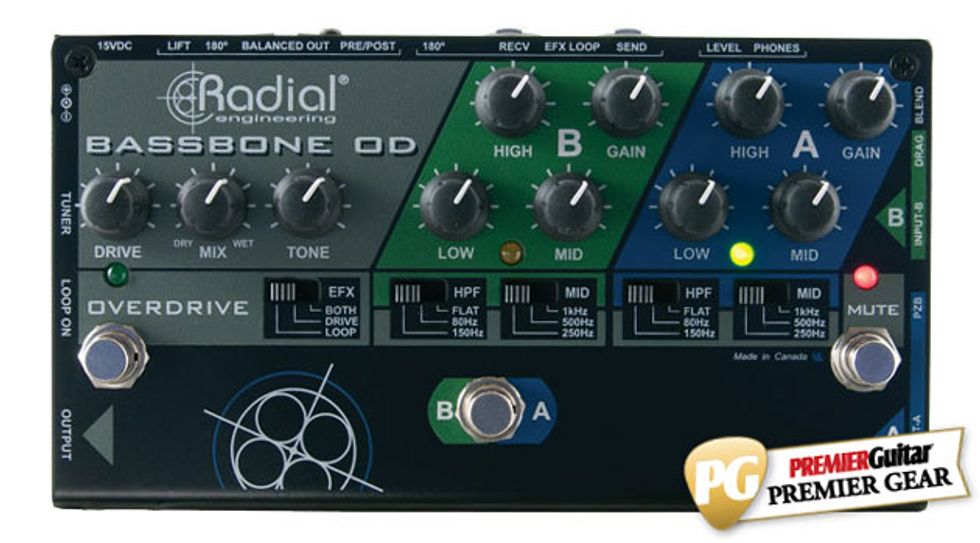
Radial Engineering’s Bassbone OD is a 2-channel preamp/overdrive with EQ, adjustable impedance, and other bass-friendly features in a rugged, 14-gauge steel enclosure. You can change channels via footswitch—a handy solution for players who must alternate between two instruments requiring contrasting settings.
Ohm Sweet Ohm
Each of the Bassbone’s channels lets you set the optimal impedance for your pickups—though they do it in different ways. Input A is switchable between 220k and 10M ohms, with the higher value intended to give piezo-equipped instruments a warmer, fuller tone. Input B’s impedance is continuously variable between 220k and 1.8M ohms via a “drag” control that can mimic the sound of an instrument plugged directly into an amp with no buffer stages. A blend switch lets you engage both channels simultaneously—perfect for upright players who rely on two pickups or a piezo/mic combination.
Each channel has its own EQ section with gain, high, and low knobs, plus a midrange control with three preset center frequencies: 250, 500, and 1k Hz. There’s also a high-pass filter switchable between 80 and 150 Hz for alleviating boomy resonance.
The overdrive circuit rewards players with even more tonal options. There are the expected drive, mix, and tone controls, plus a 3-position EFX switch that alters the behavior of the overdrive footswitch so that it engages the Bassbone OD’s effect loop, activates the overdrive circuit, or both. (There’s also a loop-on button for players who want to keep the loop constantly engaged while toggling distortion on and off.) Other thoughtful features include tuner output, mute, DI, headphone jack (with level control), polarity buttons for the effect loop and DI, and a handy cable clamp.
Ratings
Pros:
Excellent sound. Powerful tone-sculpting capabilities. Solid construction. Many useful extras.
Cons:
Large format requires lots of pedalboard space.
Tones:
Ease of Use:
Build/Design:
Value:
Street:
$349
Radial Engineering Bassbone OD
tonebone.com
Salute Your Solution
I auditioned the Bassbone OD on two gigs, using an Epifani AL 112 combo and AL 112 extension cabinet for both. For the first show I played a Sadowsky Metro Will Lee 4-string and a Nash P-style in support of an 11-piece horn band. The Sadowsky was in input A with the high-impedance button engaged, lending the J-style bass punchiness and presence that sat well in the mix. The Nash ran through input B with the drag control at about 11 o’clock.
Transitions between instruments were quiet and quick, thanks to the A/B footswitch. The EQs provided responsive tone sculpting, from a mid bump for bridge-pickup articulation to scooped, slap-friendly timbres.
The Bassbone OD’s overdrive not only sounded great, but better than many pedals that are solely dedicated to the effect. It was easy to add a slight boost to the low-end to preserve the foundation of the bass’ tone, and it was a breeze dialing in just the right amount of dirt for songs like Sly & the Family Stone’s “Dance to the Music” and Parliament’s “Flashlight.” Though the pedal’s overdrive didn’t completely replicate what you might get from pushing a tube amp, the effect was quite responsive to the touch. And beyond flawlessly tackling soul classics, the right mix of the Bassbone’s overdrive and EQ is capable of producing a variety of sick sounds that will satisfy anyone from Jesse Keeler fans to Billy Sheehan wannabes.
The second gig I used the Bassbone for required 5-string electric bass and an upright. I plugged a Ritter R8 into input B, and a German upright equipped with a Fishman Full Circle pickup into input A, whose high-impedance setting provided a warm, responsive boost for the piezo pickup. Setting the high-pass filter to 150 Hz tempered the upright’s overwhelming lows. I couldn’t completely remedy the harsh mids that plagued my upright via the Bassbone OD’s mid controls, but the pedal smoothed the sound enough to emphasize the instrument’s woody character.
The Verdict
Like a sonic Voltron, the Bassbone OD combines a host of problem-solving components in one mighty machine. In both live and studio settings, it lets you dial in optimal sounds for two instruments and toggle between them swiftly and silently. It’s also great for upright bassists who rely on two transducers. With its stellar sounds, useful extras, rugged construction, and fair price, the Bassbone OD is a powerful and pragmatic tool for the working bassist.
Watch the Review Demo:








![Rig Rundown: AFI [2025]](https://www.premierguitar.com/media-library/youtube.jpg?id=62064741&width=1245&height=700&quality=70&coordinates=0%2C0%2C0%2C0)












 Shop Scott's Rig
Shop Scott's Rig















































